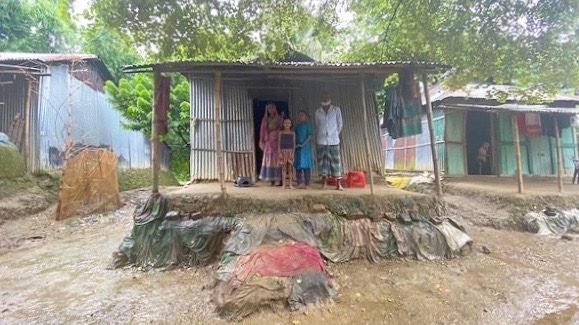Rising sea levels and extreme flooding in Bangladesh are devastating lives and livelihoods. This year, floods in Bangladesh killed more than 100 people and, according to AFP, eroded at least 1,800 hectares (4,500 acres) of land according to estimates by Bangladesh’s Center for Environmental and Geographic Information Services (CEGIS). The homes of at least 10,000 people were also affected.
Totally, as many as 7.2 million have been affected by the floods, as per the International Federation of Red Cross (IFRC) and Red Cross Societies, and nearly half a million had to flee their homes and take refuge elsewhere as water levels rose this summer.
As per a report published by the Intergovernmental Panel on Climate Change (IPCC) in February, climate change is also severely impacting the country’s food production. According to New Age Bangladesh, the report points with alarm to the “declining production” of basic food grains such as rice and wheat, by 12-17% and 12-61%, respectively, by “mid-century.”
With a population of 170 million in an area of 148,000 square kilometers, Bangladesh is one of the countries worst affected by human-induced climate change. The Global Climate Risk Index 2021 named it the country 7th most affected by extreme weather over the past two decades.
A study published in the journal Earth’s Future in March 2021 suggests that by 2050, sea level rise could affect as many as 1.3 million people across Bangladesh. In a statement, South Asians for Human Rights (SAHR) points out that the populous, low-lying Ganges Delta region “is primed to be inundated if the oceans continue to rise, thus presaging a demographic catastrophe” in Bangladesh.
“There is evidence that the seas around Bangladesh have risen faster than the global average, at 6–21mm per year. As a result, the country is projected to experience a sea-level rise of 88cm by 2100,” the IFRC publication Turning the Tide notes.
“That would lead to dramatic losses of land: it is estimated that a 1m rise would inundate 18 percent of Bangladesh. Higher sea levels mean that the same cyclone-driven storm surges can reach higher and further inland, threatening ever more people,” it adds.
Global climate injustice
Activists complain that western countries are responsible for emitting most greenhouse gasses and that Bangladesh does not contribute even one percent of global emissions. Still, its entire population has to face the consequences of disasters that occur due to climate change. Activists have pointed out that people are suffering due to this ‘climate injustice.’
“This social injustice is a problem that rich people have caused. Rich nations need to do much more to help the island nations and countries of the global south that are most at risk from [and] least able to cope with climate change,” Saleemul Haq, director of the International Center for Climate Change and Development, told Peoples Dispatch.
“The simple fact is that it is rich people causing this problem. Poor people in poor countries aren’t causing climate change: their emissions are tiny,” he added.
It is also not just an external problem, but one that is made worse by the forces of capital acting from inside the country. Professor Susanta Kumar, formerly of the Shahjalal University of Science and Technology, told Peoples Dispatch that this crisis is a function of the unplanned, anti-people policies brought in by “crony-capitalists” within the country. Kumar lamented that neoliberalism’s main considerations are expansion and maximum profit at the cost of sustainability.





